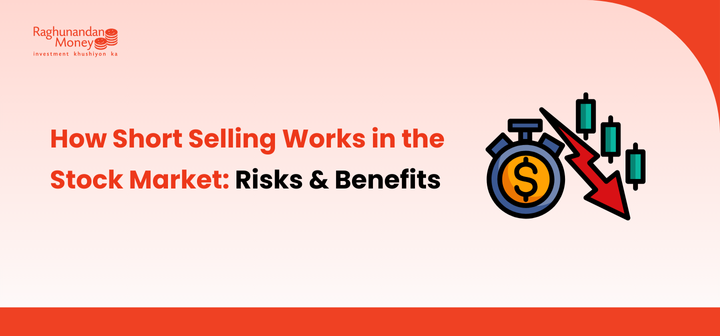How Short Selling Works in the Stock Market: Risks & Benefits
Post Date : March 1, 2025

How Short Selling Works in the Stock Market: Risks & Benefits
Disclaimer: Investments in the securities market are subject to market risks. This content is for educational purposes only and does not constitute financial advice.
What is Short Selling?
Short selling is a trading strategy where an investor borrows shares and sells them on the open market, aiming to repurchase them at a lower price later. Short sellers profit from falling stock prices, unlike long investors who anticipate price increases. While short selling offers high potential returns, it also carries significant risks, including margin calls and potentially unlimited losses.
Why Do Investors Engage in Short Selling?
- Speculation – Investors may short a stock if they expect its price to decline due to upcoming earnings announcements, economic conditions, or other factors. They sell borrowed shares at a higher price, then buy them back at a lower price to return them to the lender, profiting from the difference.
- Hedging Risk – Investors with long positions in a stock may short sell a related security to protect themselves from downside risk. This strategy helps manage portfolio volatility.
Example of Short Selling
Mr. A believes that XYZ Ltd., currently trading at ₹1,000 per share, will decline in value due to poor earnings expectations. To capitalize on this prediction, he executes the following short-selling trade:
- Borrowing & Selling – Mr. A borrows 100 shares of XYZ Ltd. from his broker and sells them at the current market price of ₹1,000 per share.
- Total sale proceeds: 100 × ₹1,000 = ₹1,00,000
- Price Drop & Buyback – A week later, XYZ Ltd.’s stock price falls to ₹900 per share, as expected. Mr. A buys back 100 shares at the new lower price.
- Total repurchase cost: 100 × ₹900 = ₹90,000
- Profit Calculation – Mr. A returns the borrowed shares and books a profit.
- Profit: ₹1,00,000 (sale proceeds) – ₹90,000 (buyback cost) = ₹10,000 (excluding brokerage & taxes)
However, had the stock price increased instead of dropping, Mr. A would have incurred losses. If XYZ Ltd.’s price surged to ₹1,100 per share, the buyback cost would have been ₹1, 10,000, resulting in a ₹10,000 loss instead. This demonstrates the high-risk, high-reward nature of short selling.
Advantages of Short Selling
- Market Liquidity – Short selling increases market liquidity, improving price discovery and reducing bid-ask spreads.
- Hedging Benefits – Investors can hedge long positions, reducing overall portfolio risk.
- Efficient Capital Allocation – Proceeds from short selling can be reinvested in long positions, optimizing portfolio management.
- Enhanced Returns – A balanced portfolio with both long and short positions can improve risk-adjusted returns.
Disadvantages of Short Selling
- High Risk – Stocks can rise unexpectedly, leading to potentially unlimited losses.
- Borrowing Constraints – If a stock has limited availability, borrowing shares for short selling can be challenging.
- Regulatory Restrictions – Exchanges may impose restrictions or bans on short selling during extreme market conditions.
- Forced Buyback (Short Squeeze) – If stock prices rise sharply, short sellers may be forced to buy back shares at higher prices, leading to further losses.
- Margin Requirements – Short selling often involves margin trading, requiring traders to maintain a minimum balance. A margin call can force traders to cover their positions at a loss.
Risks of Short Selling
- Timing Risks – Even if a stock is overvalued, prices may not drop immediately. Traders might incur interest and margin costs while waiting for a decline.
- Leverage Risks – Since short selling often involves borrowing, traders must maintain sufficient funds in their accounts. If losses exceed a certain limit, they may need to deposit additional funds.
- Stock Price Reversals – Companies can recover from downturns through strong management and strategic decisions. If a trader bets against the wrong company, they may face losses instead of profits.
- Obligation to Return Shares – Borrowed shares must be returned within a specified time. Failure to do so can result in penalties or regulatory scrutiny.
- Regulatory Changes – Market regulators can impose sudden restrictions on short selling to prevent panic-driven price declines.
- Going Against Market Trends – Stock prices generally rise in the long run. Short selling bets against this trend, making it inherently riskier.
How Is Short Selling Different from Regular Investing?
Unlike traditional investing, where traders buy stocks hoping for price appreciation, short selling involves betting on price declines. Additionally, regulatory rules may limit short selling—for example, la restriction preventing short sellers from driving down a stock’s price if it drops more than 10% in a single day.
Need Help?
Contact RMoney’s support team:

Stock Trading Now trade in ₹9 Per Order or ₹ 999 Per Month Plans.
Future & Options Access F&O contracts with advanced tools for hedging and speculation.
Currency Trading Trade in major currency pairs and manage forex exposure efficiently.
Commodity Trading Diversify Trading with MCX & NCDEX by Trading in Gold, Silver, Base Metals, Energy, and Agri Products.
Margin Trading Funding Boost your buying power with upto 5X, Buy now Pay Later
Algo Trading Back test, Paper Trade your logic & Automate your strategies with low-latency APIs.
Trading View Leverage Trading View charts and indicators integrated into your trading platform.
Advanced Options Trading Execute multi-leg option strategies with precision and insights.
Stock Lending & Borrowing Earn passive income by lending stocks securely through SLB.
Foreign Portfolio Investment Enable NRIs and FPIs to invest in Indian markets with ease and compliance.
IPO Invest in upcoming IPOs online with real-time tracking and instant allotment updates.
Direct Mutual Funds 0% Commissions by investing in more than +3500 Direct Mutual Fund Scheme.
Corporate FDRs Earn fixed returns with low-risk investments in high-rated corporate fixed deposits.
Stocks SIPs Build long-term wealth with systematic investment plans in top-performing stocks.
Bonds & NCDs Access secure, fixed-income investments through government and corporate bond offerings.
Depository Services Safely hold and manage your securities with seamless Demat and DP services with CDSL.
Journey Tracing our growth and milestones over time.
Mission & Vision Guided by purpose, driven by long-term vision.
Why RMoney Platform Smart, reliable platform for all investors' needs.
Management Experienced leadership driving strategic financial excellence.
Credentials Certified expertise with trusted industry recognition.
Press Release Latest company news, updates, and announcements.
Testimonials Real client stories sharing their success journeys.
7 Reasons to Invest Top benefits that make investing with us smart.
SEBI Registered Research Trusted insights backed by SEBI-compliant research.
Our Technology Advanced tools enabling efficient online trading.
Calculators Access a suite of smart tools to plan trades, margins, and returns effectively.
Margin Calculator Instantly check margin requirements for intraday and delivery trades.
MTF Calculator Calculate MTF funding cost upfront to ensure full transparency before placing a trade.
Brokerage Calculator Know your exact brokerage charges before placing any trade.
Market Place Explore curated investment products and trading tools in one convenient hub.
RMoney Gyan Enhance your market knowledge with expert blogs, videos, and tutorials.
Performance Tracker Track our research performance with full transparency using our performance tracker.
Feedback Share your suggestions or concerns to help us improve your experience.
Downloads Access important forms, software, and documents in one place.
Locate Us Find the nearest RMoney branch or service center quickly.
Escalation Matrix Resolve issues faster with our structured support escalation process.
Back Office Log in to view trade reports, ledger, and portfolio statements anytime.
Account Modification Update personal or bank details linked to your trading account.
Fund Transfer Transfer funds instantly online with quick limit updation to your trading account.
Bank Details View our registered bank account details for seamless transactions by NEFT, RTGS or IMPS.
How to Apply IPO Step-by-step guide to apply for IPOs using your trading account.
RMoney Quick Mobile App Trade on-the-go with our all-in-one mobile trading app.
RMoney Quick login Quickly access your trading account through the RMoney Quick web-based trading.
RMoney Rocket Web Version Experience powerful web-based trading with advanced tools for algo traders.
RMoney Rocket Mobile Version Trade anytime, anywhere with our feature-rich mobile trading platform.













